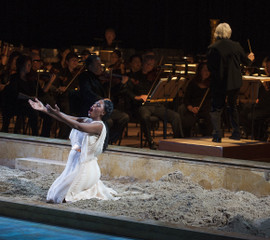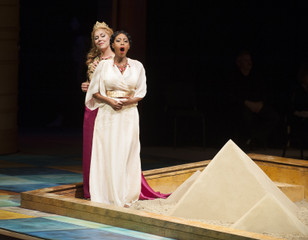|
Back
Kelebogile Besong’s Aida triomphante Orange County
Renée and Henry Segerstrom Concert Hall
02/23/2017 - & 25, 28 February 2017
Giuseppe Verdi: Aida
Kelebogile Besong (Aida), Arnold Rawls (Radamès), Milena Kitic (Amneris), Mark Delavan (Amonasro), Julian Close (Ramfis), Philip Skinner (King of Egypt), Renée Tatum (High Priestess), Nicholas Preston (Messenger), Tyquan Christie, Raymond Ejiofor, Lisa Gillespie, Isaac Huerta, Natalie Iscovitch, Andrew Martinez (Dancers)
Pacific Chorale, John Alexander (Artistic Director of Pacific Chorale), Robert Istad (Chorus Master), Pacific Symphony, Paul Manaster (Associate Concertmaster), Carl St. Clair (Conductor)
Mary Birnbaum (Stage Director), Grace Laubacher (Scenic Designer), Katie Wilson (Costume Designer), Anshuman Bhatia (Lightning Designer), Ora Jewell-Busche (Wig and Makeup Designer)

(© Nick Koon)
It’s hard to make a clean cut from an expectant Aida that honors itself with lavish sets and props alongside majestic processionals. But in this case Carl St. Clair breaks the mold again with a pared down version of this monumental opera, similar to last year’s successful concert staging of Turandot. Ever since Opera Pacific sadly shut its doors in 2008, Maestro St. Clair has maintained a vision of expanding his attendance base by bringing into the fold those of an operatic persuasion. What makes perfect sense for Orange County goers is his “Symphonic Voices” initiative, now entering its sixth season. Carl St. Clair makes a grand statement by highlighting his assets in toto under the Pacific Symphony moniker. What better example than to perpetuate classical passion by bringing Verdi’s most beloved melodramatic work to Segerstrom Concert Hall that features a strong cadre of principals.
Stage Director Mary Birnbaum staunchly supports a scaled down Aida, whereby saying, “music is the center of the opera.” Though the “strength in numbers” adage is promulgated by combining full orchestra and the 120 plus Pacific Chorale, Ms. Birnbaum is still able to hone in on lead singers and provide a level of intimacy with the audience, leaving a plausible impression.
Grace Laubacher cleverly crafts economies of scale via suggestive and minimal detail. A rectangular pit acts as the “center stage” replete with precisely constructed Egyptian pyramids, obelisks and a sphinx made of silica compound (only to be confusingly destroyed by the Egyptians themselves in Act I.) But much of the funneling of Verdi’s delectable arias and duets are “sandboxed” inside these geometrical boundaries.
At the youthful age of 28, Kelebogile Besong’s vocal abilities are nothing short of phenomenal. Her Aida is truly visceral as this operatic journey is all too familiar to her, likening the Ethiopian princess to her South African roots and experiences of apartheid. The dramatic soprano turns on a dime, capable of radiating over and above tutti orchestra, yet poised for a quixotic shift of pianissimo phrasing that melts like butter. One could listen to Ms. Besong’s delicate, demure and demonstrative voice 24/7, for her innate ability to express and nuance are thrilling, to say the least. Her “Nile Scene” deepens our sadness, yet exudes loving warmth while generating heartfelt pathos.

(© Nick Koon)
Perennial favorite Milena Kitic has the perfect smoky mezzo build as Aida’s antagonizing agent and scheming Amneris. Julian Close doesn’t leave anything to guess when it comes to his absorbing bass register while singing Ramfis though the guessing keeps coming when we ponder the question of why Kate Wilson dressed him in a slick-white leisure suit. Another asset to take the stage is through Mark Delavan and his portrayal of Amonasro in what could be described as one of most poignant pieces inside Verdi’s oft created father/daughter duets. The tension mounting inside Act III’s “Pur ti reveggo” is a pure nail-biter.
Left for discussion is Radamès, taken up by tenor Arnold Rawls. Aida’s male lead is a particular challenge to any tenor when encountering “Celeste Aida” so early on. We surmise Mr. Rawls could have been better prepared since the landmark aria appears tentative. “Time heals” as we move forward, and the squillo in his tenor voice begins to radiate with a crowned edge as we see him really digging into the character. Though most of Ms. Wilson’s fittings are filigreed with stately design, the latter comment can’t be said about Radamès’ attire: why is he dressed up looking (at times) like a bartender? Alas, for this important (and critical) prop drops the male role down a notch or two.

(© Nick Koon)
One of Verdi’s loveliest finales, “O terra, addio”, features the Besong/Rawls duo that’s emotionally captivating only to be topped when sprinkled with Pacific Symphony’s diaphanous string accompagnato. It’s hard to leave the Hall with a dry eye.
If for just a chance to hear Kelebogile Besong sing, it’s well worth the visit to the Segerstrom Concert Hall. Superb opera in a concert setting.
Christie Grimstad
|